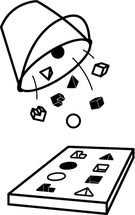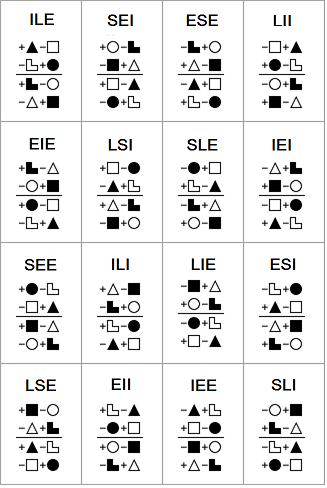Model of the Type of Information Metabolism (TIM). What is the "A-Model"?
The TIM model had been a brilliant dicovery of Ausra Augustinavichiute. Her research was based works of K. Jung and A. Kempinski. Eventually the Ausra Augustinavichiute's model had become known the "A-Model".
What is the model about?
Each of the eight information elements is processed in the human psyche by a dedicated function. Thus, the model has 8 functions to handle information elements coming from the outside world. Here we must mention that the term "outside" is used in relation to the human mind, so that any information from the physical body, such as a feeling of heaviness in the stomach, is also regarded as external to the mind. Let's imagine the following locker with 8 shelves:
| 1 | 2 |
| 4 | 3 |
| 6 | 5 |
| 7 | 8 |
This figure represents the numbering sequence of functions adopted in socionics.
Functions process information not in the same way. Non only each function processes only one information element, but it also serves for a specific purpose, and that makes the difference between the functions. Functions' work could be compared to that of any device, in which each part has its own task. For example, a computer has a power button, there is a block of memory, CPU, etc. No device ever performs the functions of another device, but there is communication between them and the possibility to transfer control from one device to another.
The same thing is true for the model of information processing. Each function performs a specific task, all the functions together are lincked ( in blocks and superblocks) and there is control transfer (not to confound with information transfer) between the functions. It is important to remember that not information is passed from function to function, but control ("I have done my task - now you do yours").
 How does information get into this processing device? Information arrives not to a particular function, but "falls" onto the entire model at once, i.e. simultaneously on all its cells (functions). In fact, the information flow is not divided into separate elements. We did this conditional division (modeling). In reality information is a continuous undivided flow. At this point the word "flow" needs to be clarified. It would be naive to imagine how a flow(for example, similar to the flow of fluid) is flowing from the outside world into our psyche. The word "flow" is a figure of speach which conveys the idea of the entire mass, entire volume of information perceived mentality. Let me remind you that the information does not exist on ots own, it happens to become information for us, appears only in the moment of interaction with the world (with some part of it). At any point of interaction with the world, we get a lot of information, containing all the information elements. And all this volume falls on the entire model. And the functions of the model are handling all this load. Each function filters out only the part (the element) of the total mass, that is processed by the function. Thus, a certain function processes only information relevant to the P element, another one processes the R element, etc.
How does information get into this processing device? Information arrives not to a particular function, but "falls" onto the entire model at once, i.e. simultaneously on all its cells (functions). In fact, the information flow is not divided into separate elements. We did this conditional division (modeling). In reality information is a continuous undivided flow. At this point the word "flow" needs to be clarified. It would be naive to imagine how a flow(for example, similar to the flow of fluid) is flowing from the outside world into our psyche. The word "flow" is a figure of speach which conveys the idea of the entire mass, entire volume of information perceived mentality. Let me remind you that the information does not exist on ots own, it happens to become information for us, appears only in the moment of interaction with the world (with some part of it). At any point of interaction with the world, we get a lot of information, containing all the information elements. And all this volume falls on the entire model. And the functions of the model are handling all this load. Each function filters out only the part (the element) of the total mass, that is processed by the function. Thus, a certain function processes only information relevant to the P element, another one processes the R element, etc.
By substituting in the above digram the numbers by the symbols of information elements, which are being processed by respective functions, we'll get 16 models of information processing or 16 types of information metabolism (TIM).

IL- Intuitive logical extravert (Don Quixote)
SE- Sensory ethical introvert (Dumas)
ES- Ethical sensory extravert (Hugo)
LI- Logical intuitive introvert (Robespierre, Descartes)
ET- Ethical intuitive extravert (Hamlet)
LF- Logical sensory introvert (Maxim Gorky)
FL- Sensory logical extravert (Zhukov)
TE- Intuitive ethical introvert (Yesenin)
FR- Sensory ethical extravert (Napoleon, Caesar)
IP- Intuitive logical introvert (Balzac)
PT- Logical intuitive extravert (Jack London)
RF- Ethical sensory introvert (Dreiser)
PS- Logical sensory extravert (Stierlitz, Holmes)
RI- Ethical intuitive introvert (Dostoyevsky, Watson)
IR- Intuitive ethical extravert (Huxley)
SP- Sensory logical introvert (Gabin)
The name of the TIM represents a two-letter acronym composed of the two ego functions (a most commonly used pseudo is given in brackets).
It should be noted that the rules do not permit arbitrary combination functions. As the table shows, the functions alternate in color (white alternates with black), horizontal pairs are formed by one rational (logic or ethics) and one irrational (sensing or intuition) function.
 Now the functions are not only numbered but also are linked to information elements that they process. Lets take as an exaple Function 1 : P and Function 2 : S. You might have noticed that, in fact, elements and functions can have the same notation. One could say "element P" (business logic), or alternatively one could say "function P" (business logic). However, aspects and functions should not be confused, which often happens to the beginners of socionics. Lets sort out things once more.
Now the functions are not only numbered but also are linked to information elements that they process. Lets take as an exaple Function 1 : P and Function 2 : S. You might have noticed that, in fact, elements and functions can have the same notation. One could say "element P" (business logic), or alternatively one could say "function P" (business logic). However, aspects and functions should not be confused, which often happens to the beginners of socionics. Lets sort out things once more.
Element is that which is processed by the psyche (part of the information flow.)
Function is that which processes (apparatus of the psyche) information.
Eglit IM ©